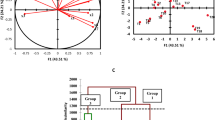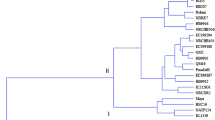Abstract
In three year field experiments (2001 – 2003) the growth, yield and productivity of 8 flax cultivars were compared. Cultivars ‘AC Linora’, ‘Flanders’, ‘Linola™ 947’, ‘Norlin’ and ‘Omega’ were obtained from Canada, ‘Barbara’ and ‘Hungarian Gold’ from Hungary and ‘Opal’ from Poland. Apart from the estimation of the yield of aboveground parts dry matter and seed yield the determinations of the primary index value of growth analysis were done and on their basis the indices LAI, LAD, RGR, CGR and HI were calculated.
The obtained yield results of the examined flax cultivars show significant genotypic — environmental relationships pertaining to the dynamics of dry matter accumulation and the amount of seed yield. Meteorological conditions in the successive years significantly influenced the particular phases of growth and development of cultivars and the factor which increased the amount of dry matter was the air temperature during the period of plant emergence — budding. During the vegetative season with a large amount of rainfall the average seed yield was about 40 % lower than compared with a year of average precipitation and a warm second part of the second period of flax vegetation. Among the analyzed cultivars a stable yield in all the years was characteristic for cultivars ‘Flanders’, ‘Barbara’ and ‘AC Linora’ (that cultivar, however, during a wet year yielded at a low level). The assimilation leaf surface of the linseed quickly increased during the period from budding to flowering and the accumulation of dry matter of the aboveground parts lasted up to the green maturity. In the successive years of the experiment there were observed significant (linear or logarithmic regressions) relationship between the yield of dry matter and the indices of growth analysis. The biggest values of the CGR indicator were observed for the period from budding to flowering. The maintaining of a high CGR value after plant flowering in the year with a favourable course of climatic parameters was beneficial for a better yield of all flax cultivars. The low values of the RGR index after flowering of cultivar ‘Hungarian Gold’ and ‘Opal’ strictly corresponded to their low yield of seed and straw biomass.
Similar content being viewed by others
Abbreviations
- DM:
-
dry matter
- LA:
-
leaf area
- DS:
-
development stage
- GDD:
-
Growth Degree Days
- P:
-
rainfall
- K:
-
Sielianinow hydrothermal index
- CSR:
-
Cumulative Solar Global Irradiation
- LAI:
-
Leaf Area Index
- HI:
-
Harvest Index
- LAD:
-
Leaf Area Duration
- RGR:
-
Relative Growth Ratio
- CGR:
-
Crop Growth Ratio
References
Aufhammer W., Wägner W., Kaul H.-P., Kübler E. 2000. Radiation use by oil seed crops — a comparison of winter rape, linseed and sunflower. J. Agron. & Crop Sci. 184: 277–286. In German.
Bazzaz F. A., Harper J. L. 1977. Demographic analysis of the growth of Linum usitatissimum. New Phytol. 78: 193–208.
Beadle C.L. 1993. Growth analysis. In: Photosynthesis and production in changing environment. A field and laboratory manual, Eds. D.O. Hall, J.M.0. Scurlock, H.R. Bolhar-Nordenkampf, R.C. Leegood and S.P. Long. Chapman and Hall, London. 36–46.
Casa R., Russell G., Lo Cascio B., Rossini F. 1999. Environmental effects on linseed (Linum usitatissimum L.) yield and growth of flax at different stand densities. Eur. J. Agron. 11: 267–278.
Candrakova E., Bakula J. 2001. Influence of nitrogen fertilization on morphological characters, yield forming components and seed yield of oilseed flax. Acta fytotech. et zootech. 1: 9–12. In Slovak.
Diepenbrock W., Iwersen D. 1989. Yield development in linseed (Linum usitatissimum L.). Plant Res. Develop. 30: 104–125.
Diepenbrock W., Leon J., Clasen K. 1995. Yielding ability and yield stability of linseed in Central Europe. Agron. J. 87: 84–88.
Diepenbrock W. 2001. Crop physiology of oilseeds: a comparative analysis between rapeseed (Brassica napus L.), sunflover (Helianthus annuus L.), and linseed (Linum usitatissimum L.). Scientia Agric. Bohemica 32: 323–339.
Easson D.L., Molloy R.M. 2000. A study of the plant, fiber and seed development in flax and linseed (Linum usitatissimum) grown at a range of seed rates. J. Agric. Sci., 135: 361–369.
Flax Council of Canada. 1998. Growing flax: Production, management and diagnostic guide. Flax Couc. of Can. Winnipeg, MB.
Froment M.A., Cook S.K., Booth E.J. 2000. Evaluation of linseed cultivars in England and Scotland. Tests of Agrochem. and Cult. No 21: 27–28.
Gawro ska H. 1980. Photosynthesis, assimilation transport and accumulation in rye cultivation differing in yield potential. PhD thesis, IHAR, Radzików. In Polish.
Gilbertson O.H.G. 1990. Linseed (seed flax). Outlook on Agriculture 19: 243–249.
Hassan F.U., Leitch M.H. 2000. Influence of seeding on contents and uptake of N, P and K in linseed (Linum usitatissimum L.). J. Agron. & Crop Sci. 185: 193–199.
Hunt R. 1978. Plant Growth Analysis. Studies in Biology no 96. E. Arnold. London.
Johnston A.M., Tanaka D.L., Miller P.R., Brandt S.A., Nielsen D.C., Lafond G.P., Riveland N.R. 2002. Oilseed crops for semiarid cropping systems in the northern Great Plains. Agron. J. 94: 231–240.
Kvet J., Ondok J.P., Necas J., Jarvis P.G. 1971. Methods of growth analysis. In: Sestak Z., Catsky J. (eds), Plant Photosynthetic Production Manual of Methods. Dr W Junk N. V. Publishers, The Haque. 343–392
Lambers H., Porrter H. 1992. Inherent variation in growth rate between higher plants: a search for physiological causes and ecological consequences. Adv. Ecol. Res., 23: 187–261.
Marshall G., Morrison I.N., Nawolsky K. 1989. Studies on the physiology of (Linum usitatissimum L.): The application of mathematical growth analysis. In Flax: Breeding and utilisation, Kluwer. 39–47.
Marshner H. 1995. Mineral nutrion of higher plants. Academic Press, Hardcourd Brace and Company.
Niczyporowicz A.A. 1984. Energy efficiency of photosynthesis and plant productivity. Acta Physiol. Plant., 6: 105–126.
Petr J. erny V., Hruska L., 1988. Yield formation in the mainfield crops. St. Agr. Pub.H. Praque.
Pietkiewicz S. 1985. Metodyka prac do wiadczalnych i technika oblicze we wksa nikowej analizie wzrostu ro lin. Wiad. Bot. 29: 111–126. In Polish.
Radomski C. 1978. Agrometeorologia PWN Warszawa. In Polish.
Rozbicki J.1997. Agrotechniczne uwarunkowania wzrostu, rozwoju i plonowania pszen yta ozimego. Fundacja Rozwoju SGGW. Warszawa. In Polish.
Saeidi G., Rowland G.G. 1999. Seed colour and linolenic acid effects on agronomic traits in flax. Can. J. Plant Sci. 79: 521–526.
Sankari H.S. 2000. Linseed (Linum usitatissimum L.) cultivars and breeding line as stem biomass producers. J. Agron. & Crop Sci. 184: 225–231.
Sinoquet H., Andriew B., 1995. The geometrical structure of plant canopies: characterization and direct measurement methods. In: Crop structure and light microclimate, characterization and application. Ed. C. Varlet-Grancher R. Bonhomme, H. Sinquet. INRA 131–141.
Strašil Z., Vorlí ek Z. 2004. Effect of soil and weather conditions and some agriculutural practices on yield and yield components in linseed (Linum usitatissimum L.). Scientia Agric. Bohemica 35: 52–56.
Tadesse N., Lay C., Dybing C. 1997. Comparative seed yield performance of high-by-high and low-by-high crosses in flax. Plant Bred., 116: 561–566.
Zaj c T., Klima K., Borowiec F., Witkowicz R., Barteczko J. 2002 a. Yielding of linseed varieties in various site conditions. Ro 1. Oleiste. XXIII: 275–286. In Polish.
Zaj c T., Klima K., Antoniewicz J., Witkowicz R. J. 2002 b. Selected element contents formation in linseed plants (Linum usitatissimum L.) depending on the of development and plant part. Acta Agrobot. 56: 37–50. In Polish.
Zaj c T. 2004. Present conditions of cultivation and utilization of linseed (Linum usitatissimum L.). Post. Nauk Rol. 308: 77–90. In Polish.
Author information
Authors and Affiliations
Rights and permissions
About this article
Cite this article
Zaj c, T., Grzesiak, S., Kulig, B. et al. The estimation of productivity and yield of linseed (Linum usitatissimum L.) using the growth analysis. Acta Physiol Plant 27, 549–558 (2005). https://doi.org/10.1007/s11738-005-0061-z
Received:
Accepted:
Issue Date:
DOI: https://doi.org/10.1007/s11738-005-0061-z




